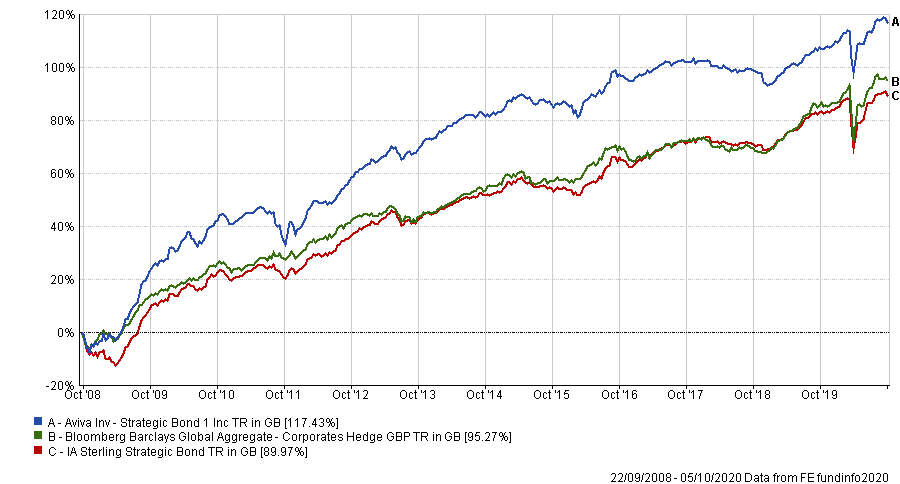Despite the swift rebound in credit spreads since the March correction, Aviva Investors’ Chris Higham and James Vokins believe the recovery in bond markets could be short lived.
The managers of the £319m Aviva Investors Strategic Bond fund said while central bank support programs have served as a strong backstop for credit spreads and corporates have generally done well to shore up their balance sheets, they are still positioning for further volatility.
Given the strength of the recovery after March this year, Higham admitted that the fourth quarter of 2020 was always likely to be the most challenging. But now that economies are facing further pressure from rising infections, turbulence in the bond markets seems even more likely as further restrictions dampen economic activity, he noted.
Within high yield and investment grade bonds there are some sectors which are under a lot more pressure – especially airlines, hotels and leisure – which Higham (pictured) said is where the defaults are likely to come. 
He said: “In March the high yield market was pricing in a 10 per cent default rate globally, right now it’s more like a 4 to 5 per cent default rate.
“That’s been driven down by a lot of the monetary and fiscal policy support seen, as well as the actions corporates have been doing such as cutting dividends, issuing equity, which as lenders we like to see.”
As yields have gone lower, companies have also been able to borrow money and, in some cases, refinance debt to avoid potential default.
Higham continued: “We’ve positioned for higher volatility because we think that there’s a good chance that with a downgrade in economy activity, we will see more downgrades from the rating agencies.
“That will put pressure on investment grade as names transition down to the high yield market.”
So far, the migration of fallen angels – investment grade bonds being downgraded into the high yield market – has probably been less than expected according to the Aviva bond managers.
“The global downgrade percentage is only around 3 per cent across investment grade credit, which is pretty small really – you can count the big names on your hand which had the biggest impact,” Higham said.
“I think there was a bigger expectation for more and that it would be in line with recessions of the past like the global financial crisis, where a number of financials were downgraded, or the dotcom crash, where a number of telecoms were downgraded.”
Higham – who has managed the fund since it launched during the height of the global financial crisis in 2008 – explained: “This time around the behaviour from the corporates, given that markets have been open to them, they’ve shored up their balance sheets quicker and better than expected. So there have been less downgrades.”
He said one could argue a lot of the companies that have been downgraded recently had already given an indication of whether they would use some of the levers to manage their balance sheet.
“We have seen dividends being cut and equity being raised across the board, and we continue to think that’s likely to happen where they have the ability to do that,” he explained. “It depends on how demand develops.
“Having said, that there is a large weight of low-down BBBs to remind us of a growing area of investment grade that is potentially at risk, particularly if we get a second wave.”
Understanding company strategy and what levers they can pull to respond to the coronavirus pandemic or further restrictions is crucial for the bond managers.
“From our perspective we want to be lending to companies where the strength of the balance sheet is pretty high up their agenda, but the reality is these things change depending on the company outlook, sector outlook and the economic outlook,” Higham explained.
James Vokins – who has managed the fund with Higham since June 2016 – said meeting management and understanding their strategy is key to knowing what levers they are likely to pull next to satisfy their stakeholders, of which largely the shareholders are front and centre.
He said: “Sometimes the creditors and shareholders are aligned, and there are plenty of examples of that where de-levering is the number one priority and that works for both sets of stakeholders, but very often you see dividends being left on at the expense of more leverage and more issuance.”
The potential volatility and disruption caused by the pandemic has on the other hand created opportunity for the managers because it has accelerated a structural trend driving consolidation within the telecom sector, an area which the fund has been highly focused on for the last 10 years.
“The telecoms sector is an example of where we could very well see more pressure to consolidate because of share price performance as a consequence of the pandemic,” Vokins said.
“As a lender you want to lend money to the weaker player that gets acquired by the strong player.”
“Typically, the weaker players have lower credit ratings, and get acquired by stronger companies with better credit ratings, and their debt benefits from that support from the stronger balance sheet of the acquiring parent.”
“It also might mean that gets refinanced, which is typically at a large premium.”
Since launch in 2008, Aviva Strategic Bond has delivered a total return of 117.43 per cent versus the average bond in the IA Sterling Strategic Bond sector which returned 89.97 per cent. Its benchmark, the Bloomberg Barclays Global Aggregate returned 95.27 per cent over the same period.
Performance of fund vs sector since launch

The fund has an OCF of 0.88 per cent and is currently yielding 1.9 per cent.




